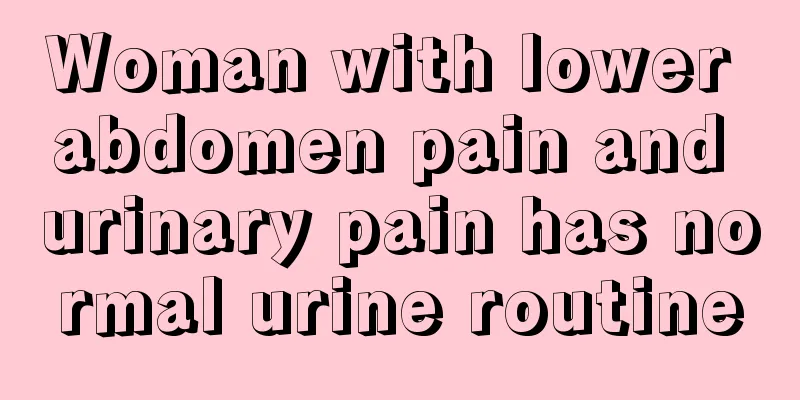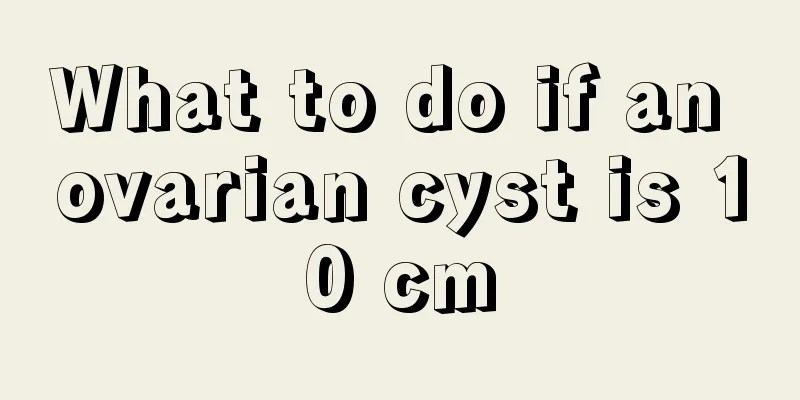Woman with lower abdomen pain and urinary pain has normal urine routine

|
Generally speaking, women have worse physical constitutions than men, and because women bear the responsibility of bearing offspring and have a small belly, they should pay more attention to their physical health at this time, because women are prone to gynecitis or gynecological diseases, and they should also pay more attention to hygiene in daily life. So what are the reasons why women have lower abdominal pain and pain when urinating but normal urine routine examination results? 1. Ovulation abdominal pain
Ovulation pain When adolescent girls ovulate, the follicle ruptures and the follicular fluid may have a certain stimulating effect on the peritoneum, so they sometimes experience mild abdominal pain that alternates between the left and right sides once a month. This is physiological, and the symptoms are mostly unilateral lower abdominal pain, dull pain or heaviness-like pain. Some girls also have a small amount of vaginal bleeding, that is, ovulation bleeding, which usually disappears on its own after one or two days, and generally does not exceed seven days. This type of abdominal pain usually does not cause any pathological changes, and the gynecological examination is completely normal. It is physiological abdominal pain and generally does not require treatment. 2. Ectopic pregnancy
Ectopic pregnancy refers to the implantation of the gestational sac outside the uterus. Among ectopic pregnancies, about 95% occur in the fallopian tube. Abnormal fallopian tube development, abnormal fallopian tube function, tumor compression, and downward migration of the intrauterine contraceptive device may all cause ectopic pregnancy. Lower abdominal pain is one of the common symptoms of ectopic pregnancy. In addition, ectopic pregnancy is also accompanied by symptoms such as amenorrhea and irregular vaginal bleeding. 3. Dysmenorrhea Dysmenorrhea is divided into primary and secondary dysmenorrhea. Primary pain is often seen in adolescent girls. It is related to the level of prostaglandins in the body, cold, emotional and psychological factors, but there is no organic disease. It can generally heal itself with age or after marriage and childbirth. Common causes of secondary pain are endometriosis and adenomyosis. The symptoms include gradually increasing pain, often in a cyclical pattern, or dull pain in the lower abdomen during non-menstrual periods that worsens before and after menstruation. In addition, it is often accompanied by infertility and menstrual disorders, which often require drug treatment. 4. Ovarian Corpus Luteum Rupture This is caused by excessive bleeding in the corpus luteum, accompanied by sudden onset of abdominal pain in the lower abdomen or one side, and in severe cases, shock may occur. Most cases of ovarian corpus luteum rupture occur between the 20th and 26th days of the menstrual cycle, and lower abdominal pain may occur at the onset, with varying degrees of severity. Before the corpus luteum of the ovary ruptures, the ovary will experience congestion and swelling. This process can be triggered when the ovary is affected by external or indirect external forces, especially when it is congested before menstruation, such as due to straining during bowel movements, trauma, sexual intercourse, or strenuous activity. It is best to go to the hospital for diagnosis and treatment immediately after the occurrence of ovarian corpus luteum rupture. Do not abuse painkillers on your own to avoid masking symptoms and affecting normal diagnosis and treatment. 5. Ovarian cyst pedicle torsion or rupture
This is because the cyst has a long pedicle, a large volume, no adhesions to the surrounding area, and is highly mobile, and twists when affected by intestinal peristalsis or changes in body position. When the pedicle of an ovarian tumor is twisted, pain suddenly occurs on one side of the lower abdomen, which is persistent colic, often accompanied by nausea and vomiting; there may be obvious tenderness and muscle tension in the abdomen; digital rectal examination may reveal swollen and tender appendages. Ovarian cysts may also rupture, and the contents of the cysts may irritate the peritoneum and cause severe pain. B-ultrasound examination can confirm the diagnosis. Emergency surgery is usually required. 6. Pregnancy-related diseases In recent years, cases of teenage pregnancy are not uncommon. Abdominal pain caused by pregnancy-related diseases can be seen in threatened abortion, ectopic pregnancy, etc. Taking ectopic pregnancy as an example, dull pain or distension in the adnexal area on the affected side may occur. When the ectopic pregnancy occurs miscarriage or ruptures, it can cause intra-abdominal bleeding. The pain symptoms vary depending on the amount and speed of bleeding. If it is a miscarriage due to fallopian tube pregnancy, the abdominal pain is often limited to one side of the lower abdomen, and blood accumulates in the rectouterine pit, which can cause anal pain. When the fallopian tube pregnancy ruptures, the amount of bleeding is large and the speed is fast. The blood quickly spreads to the entire abdominal cavity and causes pain in the whole abdomen. In addition, some pregnant girls have secret abortions, which can easily cause infections such as pelvic inflammatory disease or trauma to the pelvic organs and reproductive tract, and may even endanger their lives. |
<<: Can I get an anti-inflammatory injection for pelvic effusion?
>>: What is the best food for women's liver?
Recommend
Causes of gout in women
The main cause of gout among female friends is re...
Is it better to blanch or salt white radish for dumpling filling? How to prepare white radish for dumpling filling
We all know that white radish is a common food. I...
How to store a large amount of fresh chili peppers?
Chili is a condiment that contains a lot of vitam...
Revealed! The truth about voluntary blood donation
Follow "Body Code Decoding Bureau" (pub...
Why do pregnant women have fever headaches?
Some pregnant women will have headaches due to pr...
Is ectopic pregnancy mainly caused by males?
Most male friends like to smoke, and smoking is o...
What should I pay attention to after uterine prolapse surgery?
When you hear the term uterine prolapse, all kind...
Getting pregnant after taking ovulation-stimulating drugs once
Nowadays, due to work and work pressure, it is in...
What kind of tea is suitable for women?
Drinking tea at work and in life has the effect o...
Can black-bone chicken nourish the kidneys? How to eat black-bone chicken to nourish the kidneys
Black-bone chicken is tender and delicious, and c...
What are the small bumps on the cervix?
For health-conscious women, they will go to the h...
Leucorrhea WBC 3 Cleanliness 3
Gynecological B-ultrasound examination or dialysi...
What is the cause of the white and sticky discharge in early pregnancy?
Women undergo great physiological changes before ...
What does the dark area of uterine rectal fossa mean?
When women have gynecological examinations, they ...
What are some tips for barbecue? Why should we drink less carbonated drinks when eating barbecue?
According to ancient records, barbecued food was ...









